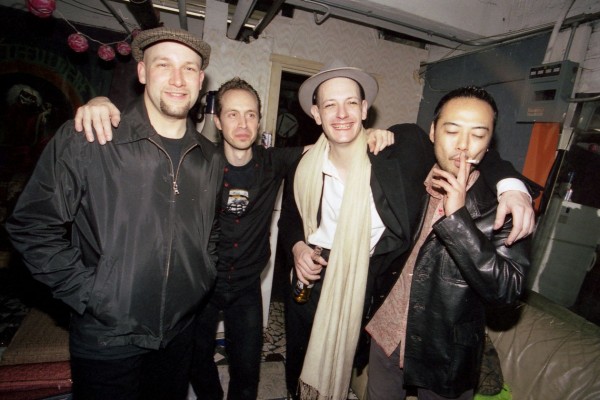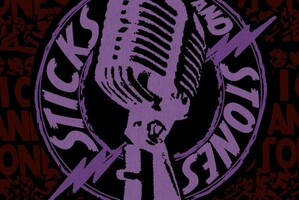
Sticks and Stones are reuniting for a single show. The band is often spoken about in a sort of reverent tone- they never had a big following, but since their demise, their fan base has grown silently and has grown even more dedicated. The group is hard to define, but frankly, no one, before or since, made music quite like them.
One wishes it was under happier circumstances, but the show is a benefit for rising Jewelry maker Lavender Buttons. Buttons recently had a very serious operation removing a substantial mass of cancer and still is fighting the battle. You can read the story of how the upcoming June 3 benefit gig came together, below.
How a Cancer Diagnosis Reunited Sticks and Stones
John Gentile
If you’re a hip New York cat, then you’re seen those unique, copper earrings hanging from the ears of trendy ladies, or those Bladerunner meets Game of Thrones necklaces tied around the necks of the lower east side avant garde artists, or those Pagan-influenced leather gauntlets bound around the wrists of some happening musicians. Those pieces, which have sparked a bit of a cult following in the Big Apple, have gained a small, but fervent fandom for their ornate design, for their refusal to follow the “rules†of jewelry making, and for their pre-History/post-apocalyptic style.
Now, if you’re a really hip New York cat, you’ve noticed that a usual face in the art and punk scene hasn’t been around too much lately. You know the one- the young lady with the long black dreadlocks, who wears big leather boots taken straight from Conan the Barbarian, who has tribal tattoos across her face, who loves bracelets that dangle and clang, who has her forehead pierced (how do they even do that?)
 Well, that’s the woman who makes that jewelry (which is worn by everyone from crust punks to school teachers to high end fashion models). Her name is Lavender Buttons and the reason that she hasn’t been around lately is that not too long ago she was diagnosed with a particularly aggressive form of cancer. The science is fairly complicated, but after being diagnosed with the same genetic disease that claimed her mother just a short time prior, Lavender was given two choices: accept her fate and hope for five more years at most, or, risk a very grave procedure and get about 90% of her large intestines removed.
Well, that’s the woman who makes that jewelry (which is worn by everyone from crust punks to school teachers to high end fashion models). Her name is Lavender Buttons and the reason that she hasn’t been around lately is that not too long ago she was diagnosed with a particularly aggressive form of cancer. The science is fairly complicated, but after being diagnosed with the same genetic disease that claimed her mother just a short time prior, Lavender was given two choices: accept her fate and hope for five more years at most, or, risk a very grave procedure and get about 90% of her large intestines removed.
Lavender remembers the earliest days of the diagnosis, “When the cancer started happening, I had my iPod on shuffle and I heard Sticks and Stones’ cover of Bruce Springsteen’s ‘Atlantic City.’ It made me cry, and I’m not even sure why it was that song. I just bawled my eyes out and listened to the song on repeat.â€
As you may know, Sticks and Stones is the long lost 90s punk band that never quite made it, despite its postmortem underground fandom. Singer Pete Ventantonio would go onto re-emerge as Jack Terricloth in World/Inferno Friendship Society. Mike Cavallaro would rename himself Johnny X and create a popular series of comic books. Chris Calello would go onto the Conspiracy. Osamu Kawahara would venture to Japan.
“It is devastating to see this happening to Lavender,†says Leora Colby, friend of Lavender, co-owner of Sit and Spin records in Philadelphia, and frontwoman for Thulsa Doom. “She is a ball of sunshine. When she walks into a room, things glow around her and she brings am aura of positive energy wherever she goes.â€
The two originally met when Lavender was traveling the East Coast in a van. “She was staying at a friends house,†Colby continues. “Well, really, she was staying in a van in front of a friend’s house. She came over and asked if she could plug a toaster oven into my electric socket. I was like, ‘Sure…’ and then, she starts making this handmade jewelry in a toaster oven!â€
“She has evolved her work into this intricate metal work,†Colby says. “When people make jewelry they’ll buy the clasps or little rings… Lavender makes those herself. I cannot imagine what it takes to execute her works- the level of skill and design is unbelievable.â€
When she was healthy, jewelry making was Lavender’s solace. “I grew up making my own things mainly because I couldn’t afford what I wanted to wear,†Lavender explains her process. “The stuff in thrift shops I didn’t like or it wasn’t made properly, so I would take it apart and redesign it. Once I got my hands on some metals and hammer, I figure out how to shape the metals and I would use a railroad track as anvil. I design everything in my head. Even when I’m making the jewelry, I’m still drafting in my head.â€
But, of course, once Lavender got sick, she had trouble working at her craft. As she got sicker, she tried to continue with her design, but it got harder and harder. Eventually, she had to make a decision- risk the operation or accept the five years.
 Lavender remembers the drive to the doctor’s office, “Jack Terricloth is such a good friend that on the way to the docotr’s office, he sang ‘Atlantic City’ to me in the car. The whole way, he did what he needed to do for me. “
Lavender remembers the drive to the doctor’s office, “Jack Terricloth is such a good friend that on the way to the docotr’s office, he sang ‘Atlantic City’ to me in the car. The whole way, he did what he needed to do for me. “
It is curious to think of THE Jack Terricloth as a sort of mother of mercy. He’s made it a point to appear as a somewhat mysterious entity to the Inferno crowd. He’s famous for his quick wit and diatribes between songs, but for all the bluster, what do we really know about him? In fact, if you peruse the Inferno catalogue, a sort of rakish character seems to appear.
“I am sick of people being sick of my shit,†is about how Tericloth dislikes people who aren’t with Terricloth’s program. “I wouldn’t want to live in a world without grudges†is about the merits of holding onto hate. “Istanbul†is about venturing off on your own without worrying about your traveling companions agenda. Hell, this is the guy that rumbled with the Adicts and with Earth Crisis!
“I’ll say this,†Lavender explains, “Jack is the best kind of friend and he will be there for anyone who he feels is worth it.â€
With Terricloth at her side, Lavender went to the doctor, got her options, and decided to take a chance. She went for the operation- an operation that involved a lot of cutting, a lot of tissue removal, and a lot of bleeding.
Lavender made it through the operation. As is the universe’s macabre demeanor, she was released from the hospital on April 8, the same day that her mother passed away from the same disease. “They cut away almost all of my intestines,†Lavendar says. “We have to make sure that everything that has to be gotten has been gotten. Right now, I’m dehydrated and drinking later is almost a full time job. I’m not out of the woods yet, but the initial operation seems to have been a success. I have to go back for pathology.â€
“I’m feeling positive,†she says. “This time two weeks ago I couldn’t get out of bed or even go to the bathroom on my own. Now, I can walk at least a few blocks. I’m feeling positive because it could have been worse.â€
As Lavendar was laid out, recovering from a very serious operation, she was unable to work on her passion, handmade jewelry. On top of that, she was facing large medical bills, rent, and a lot of other expenses that you don’t plan to have, caused by the Grim Reaper unexpectedly knocking on your door.
Seeing their friend in a state of distress, Lavender’s friends started a fundraiser for her and also, out together a benefit show- a benefit show that wasn’t impossible to foresee, but did seem very, very, very unlikely: The headlining act for Lavender’s benefit show will be the same band that meant so much to her when she got her dreadful diagnosis: Sticks and Stones.
Maybe you know Sticks and Stones and maybe you don’t. But, people that know Sticks and Stones looove Sticks and Stones.
The cliché about Sticks and Stones is that they never really got their due and were underappreciated. Perhaps it’s a bit downcast to reflect on a band as “a band that should have made it, but didn’t,†but the fact is, people did not get Sticks and Stones now. And, like so many herald bands these days, they only got their due (to a degree anyway) long after they were disbanded.
It’s difficult to describe Sticks and Stones, which may be one of the reasons that Lifetime or Bouncing Souls level of success eluded them, despite being compatriots with those bands. A mixture of classic punk, hardcore, and college rock, Sticks and Stones were complex in an age when the simplicity of hardcore or the sparseness of third wave ska was beginning to take precedence.
The band had angry songs, but they weren’t “ARRRG I HATE THE GOVENRMENT AND COPS†shouting affairs. Rather, as songs like “Reason to care†would show, the band seemed to temper their anger with a bit of solemnity. Perhaps there was too much thought behind their lyrics… while Inferno wears their collective hearts on their sleeves, swinging from tune to tune with natural impulse, Sticks and Stones seemed to be every bit as calculated and carefully plotted as the mid 80s Dischord bands (who also, not coincidentally, never really caught on like their harder, faster older brothers, Fugazi excluded, of course.)
“Sticks and Stones was a revenge band,†Terricloth says. “I had been kicked out of Neurotic Impulse for not being good enough on the guitar. I was pretty mad. I was like, ‘Fuck those guys!’ I was a very, very, very angry young man at the time.â€
“In Sticks and stones, we probably wanted to be the Clash,†Terricloth continues. “But, when we couldn’t do that, we had to figure out how to be is, and then we got weird. It was all instinctive. We wanted to get out of new Jersey and share our critical views… but, it turns out, people didn’t wan to hear about our views…â€
To be fair, the band did have a limited following. Playing gig after gig in Northern Jersey and surrounding areas. As they progressed, their songs became darker, more reflective, and to a degree, more obsequious. The band’s ghoulishly named final album, The Optimist Club, bore the track “Cynicalâ€: “Cynical, that belies something/ your disappointment betrays a belief/ you had hoped for better… hadn’t we all.â€
Maybe that’s not Byron level poetry (though maybe it is), but it certainly demonstrates a level of thought, honestly, and rawness that was, and still is, rare in the punk scene. And of course, the fact that they covered Springsteen, Blondie, and the Police wasn’t exactly easy to square with any one image.
“Sticks and Stones were everything I wanted out of a punk band,†says Zak Kaplan. Kaplan, along with Chunksaah records, is the defacto Jesuit Priest of Sticks and stones, cataloging their material, shows, and fliers. Along with Chunksaah, Kaplan curated and produced the band’s posthumous retrospective, 2003’s The Strife and Times. As Geocities falters to its inevitable death, Kaplan is the sole archivist of any substantial record of the band, online.
Kaplan says, “They were very much a punk band, but they didn’t fit in with the spiky punk bands. They weren’t hardcore, but they had followers in that scene. The line is that ‘they were ahead of their time.’ I’m not sure that’s true. It’s more like ‘they were out of time.’â€
He continues, “Here’s what made Sticks and Stones so special for me. They were the blueprint for non-blueprints. They were a breath of fresh air in a scene that copied and copied and copied off of each other.â€
“I guess we were a rebuilding- a way to get back to the roots of it all,†Terricloth reflects on the band.
I mention to him one of his earliest “famous†lines form the band, “Success is so damned crass. Did the band actually want to remain in obscurity, only to be appreciated after their demise?
“We were a little bit modest,†he says. “Bands were blowing up, and playing to the crowd, and they seemed happy to be playing to the crowd. We were never happy to be playing to the crowd. We were a punk band, so that wasn’t in our nature. We had a healthy distrust of money and success.†He continues, “but we did try very, very hard. We wanted to be popular, but on our terms, I suppose.â€
But, despite the effort, the band came to an unceremonious end. After a grueling three month tour, the band played one of their final shows in Germany. They left the stage and then came back for encore. But, upon returning, they found that all their guitar pedals had been stolen, right there, on stage, by the audience.
“It was a bad ending,†Terricloth says. “We said, ‘fuck it, let’s go home.’ We didn’t play again. We had made our statement and are very happy that our records are out there. But, honestly, we probably would not still be friends if we stayed together.â€
The band languished in obscurity until the 2003 re-release which prompted a few reunion shows over the next few years. But, not counting a sparsely attended short acoustic set (also for a cancer benefit), the band has not played as an electric, full band since 2006.
So, the reunion show plays a sort of strange role. For many, its an acknowledgement of the this long secret, deeply beloved band… yet it only comes at the cost of a dear friend’s near miss with death.
“Right now, I’m trying to get my head back on my shoulders,†Lavender says. “Mentally, I’m slowly piecing things together. The fight is still on-going but I feel sportive. This whole benefit was made in secret. I have no family. My friends just did it. Sticks and Stones means so, so much to me and they are ideal for this.â€
Thus, how can we understand this show? Is it tinged with melancholy due to its circumstances, or is it a representation that even in the worst scenarios, some good can sprout from badness? You’d have a hard time finding a more fitting band than Sticks and Stones to answer that quagmire.
The benefit for Lavender Buttons will be June 3 at Sunnyvale in Brooklyn. Sticks and Stones plays along with Leora Colby’s Thulsa Doom, Out of System Transfer, Sunny Side Social Club, and more. 
 Profile photo by Alexandra Lucca Mitchell
Profile photo by Alexandra Lucca Mitchell